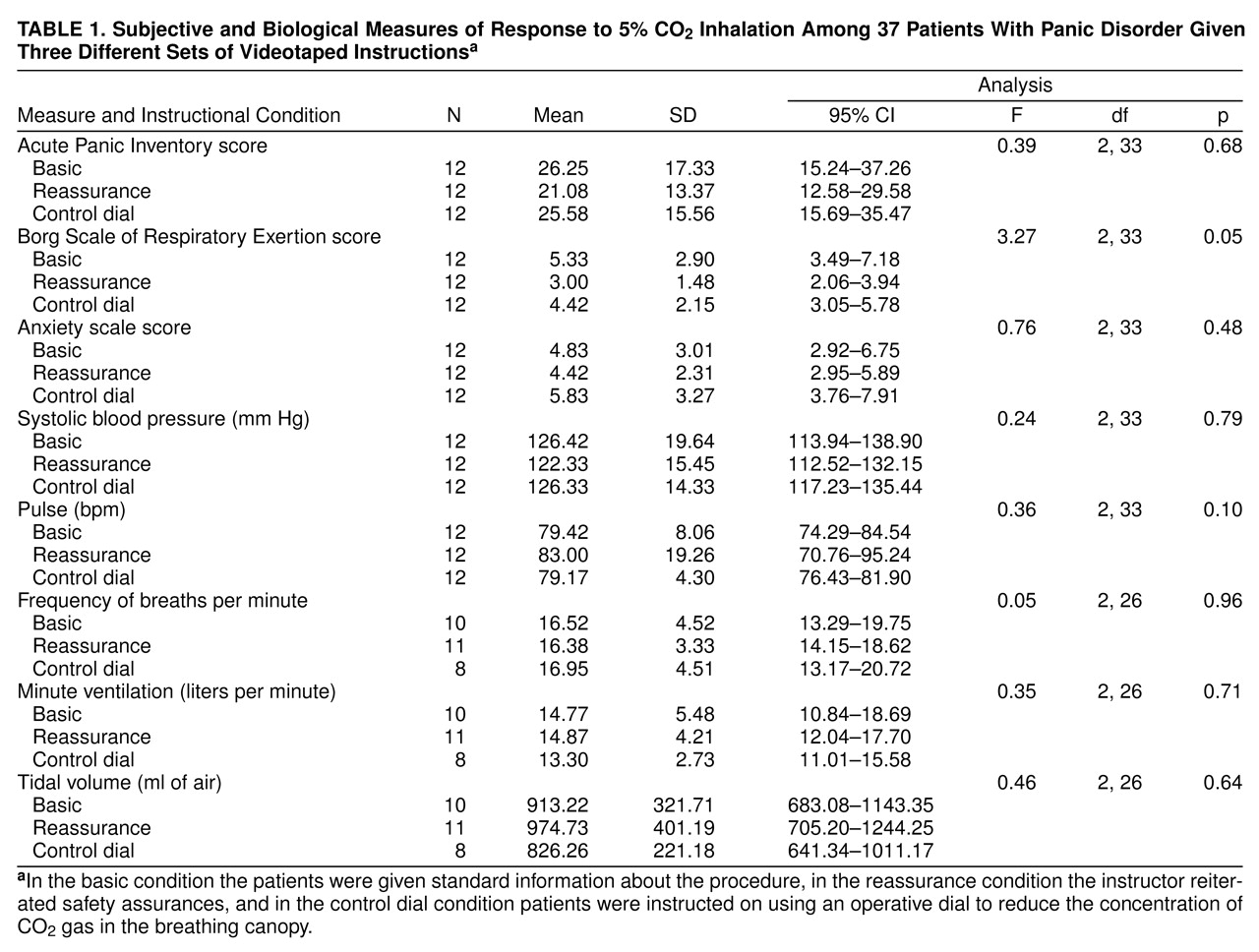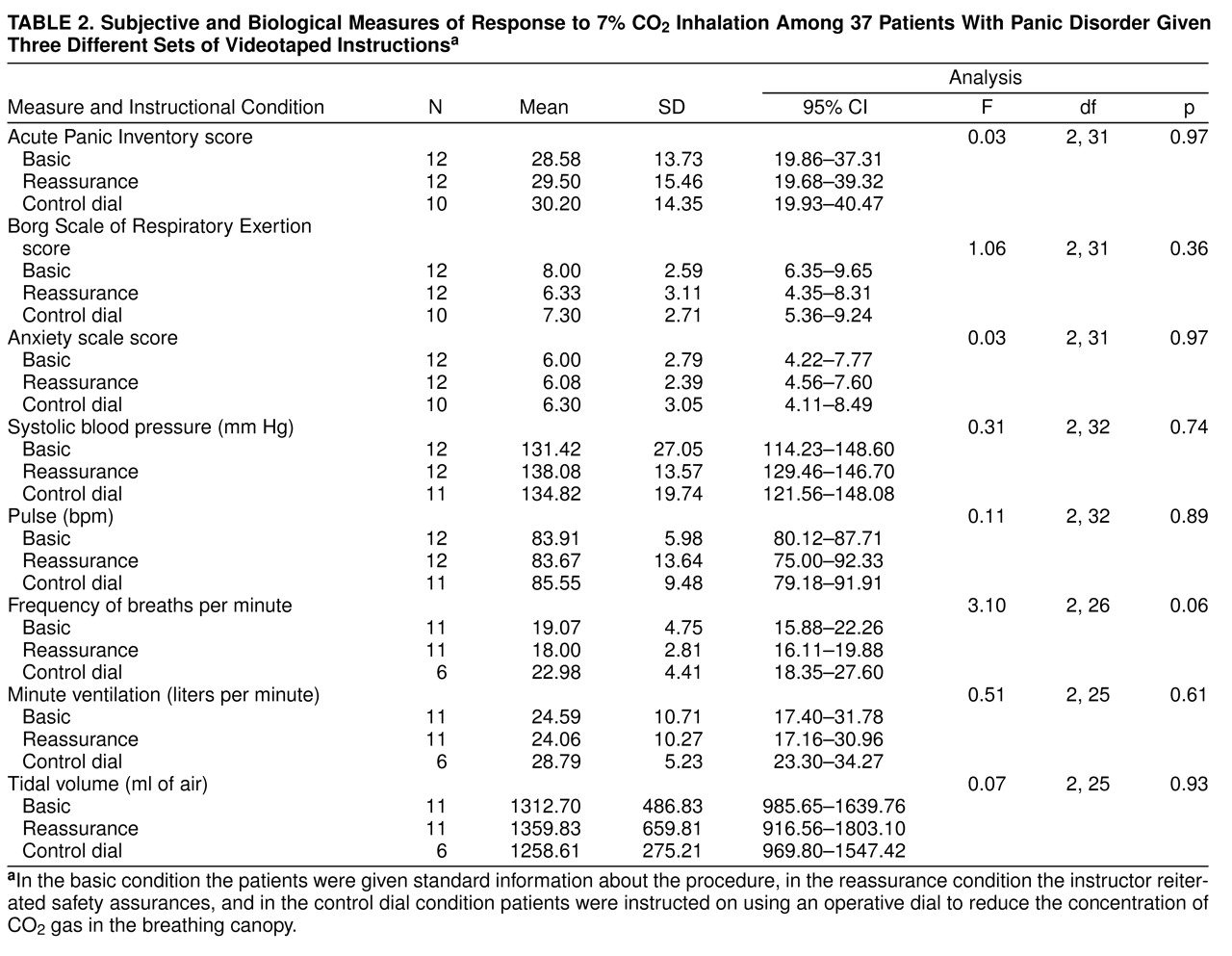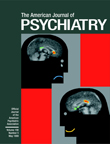There is now considerable support for the panicogenic effects of both hyperventilation
(1) and carbon dioxide (CO
2) inhalation
(2–
5). In addition to the greater likelihood of panic, CO
2 inhalation produces specific changes in respiratory and cardiovascular variables, including frequency of breaths, tidal volume, heart rate, and blood pressure. Theoretical explanations of these effects have tended to emphasize the role of biology in the formation of panic
(6).
In the past 10 years, several investigators have examined the role of cognitive mediating variables in effecting changes in physiological response to such biological challenges. For example, van der Molen and van den Hout
(7) found that normal volunteers who were told that the infusion of sodium lactate would be particularly unpleasant were more reactive to the procedure than were subjects who were told otherwise. Rapee et al.
(8) found that patients with panic disorder who were provided extensive information about the likely effects of single inhalations of a 50% CO
2/air mixture were less likely to panic and had fewer catastrophic thoughts than did patients with panic disorder who received minimal instructions. A similar study by Papp et al.
(9), which used control subjects, a large sample size, and prolonged inhalation of 5% and 7% CO
2, failed to establish a connection between instructional set and rate of panic.
In addition to the need for larger and more controlled studies, questions remain about the specificity of cognitive variables in effecting changes in panicogenic response. For example, is the critical issue related to perceived control of physiological events, expectations of the intensity of those events, or perhaps the need for reassurance that anxiety-related sensations are not dangerous? Although cognitively oriented investigators have presented numerous possible mechanisms
(8,
10,
11), rigorous study of different cognitive mediational theories remains to be done.
In the current study, we examined the full range of cognitive mediational variables by assigning subjects to one of three instructional programs as part of a larger study on the physiology of CO2 inhalation. Unlike most previous studies, this design allowed for the collection of a full array of respiratory and cardiovascular data as well as subjective reports of anxiety and independent ratings of panic.
METHOD
Subjects
Thirty-seven patients with DSM-IV-diagnosed panic disorder and 16 normal subjects (36 men and 17 women) participated in this study. Diagnoses were established by psychiatric interview and confirmed by the Structured Clinical Interview for DSM-IV
(12). Although some patients had additional axis I diagnoses, panic disorder was the primary disorder for all subjects.
All subjects were medically healthy as determined by physical examination, blood test, urine pregnancy test, and ECG. All subjects had been medication free for 2 weeks before the test with the exception of as-needed benzodiazepine (no patient was found to be using benzodiazepines). All subjects provided written informed consent after being told that they would be breathing air enriched with varying amounts of CO2 throughout a procedure lasting for 1 hour and 40 minutes. They were told that the procedure was not dangerous but that anxiety or panic could occur.
Procedure
Before the CO
2 canopy test was initiated, subjects were randomly assigned to view one of three videotapes. The first videotape gave basic instructions that included standard information about the canopy study. The second videotape provided extensive reassurance regarding any perceived dangerousness of the procedure. The third videotape instructed the subject on using a control dial to reduce the concentration of CO
2 in the canopy. Although subjects were not given information on the percentages of CO
2 in the canopy mixture, the control dial was designed to reduce CO
2 concentration in graded stages (e.g., from 7% CO
2 to 5% CO
2 on the first turn; from 5% CO
2 to 3% CO
2 on the second turn; and from 3% CO
2 to room air on the third turn). Videotaped instructions decrease experimental error and maintain sufficient credibility
(13).
The CO
2 canopy test has been described in detail elsewhere
(1,
2). Briefly, the subject’s head is placed in a clear plastic canopy in which breath-by-breath respiratory data are collected. ECG and blood pressure are monitored throughout the procedure. Immediately before and after each of the five phases of the experiment, the following rating scales were administered: the 27-item Acute Panic Inventory
(14), a 10-point Likert scale rating anxiety, and the Borg Scale of Respiratory Exertion
(15). Two cognitive validity scales assessed the effects of the instruction. The scale administered before the canopy test rated on a 4-point Likert scale the degree of “reassurance,” and the scale administered after the canopy test rated the degree to which the subject thought about safety information conveyed in the tape during the canopy procedure.
Blind to diagnosis and instruction, raters administered the rating scales and made judgments based on DSM-IV criteria about the presence of a panic attack. They were trained by viewing lactate infusions on videotape and were required to achieve interrater reliability (kappa) of 0.8 or better. Subjects responded to a rater’s questions by pointing to charts in order to prevent artifacts caused by talking. The five experimental periods were as follows: 1) room air breathing (20 minutes), 2) 5% CO2 challenge (20 minutes), 3) room air breathing (20 minutes), 4) 7% CO2 challenge (20 minutes), and 5) room air breathing (20 minutes).
Data Analysis
A series of one-by-three analyses of variance (ANOVAs) were performed on physiological variables and subjective rating scales across the three instructional programs (reassurance, control dial, and basic instructions) for both 5% and 7% CO
2 inhalation periods. Significant ANOVAs were subjected to Tukey’s honestly significant difference comparison tests in order to specify group differences. A power analysis based on expected effect size and current sample size yielded power=0.53 (two-tailed) and power=0.67 (one-tailed)
(16). Chi-square analyses of frequencies of panic were performed for both 5% and 7% CO
2 to assess the effects of instructional condition on rate of panic. The analyses of panic rate did not include the normal subjects because none of them panicked under any CO
2 condition.
RESULTS
Chi-square analyses performed across the three instructional programs (basic instructions, control dial, and reassurance) for both 5% and 7% CO2 periods failed to detect differences in independent ratings of panic (χ2=1.13 for 5% CO2 and χ2=0.28 for 7% CO2, both n.s.).
Table 1 and
table 2 provide descriptive statistics for all subjective and biological measures across the three instructional programs. The first series of one-way ANOVA used the subjective psychological measures of patients as the dependent variables and the three instructional groups as levels of independent variable. Separate analyses were performed for each of the two CO
2 levels (5% and 7%) for the Borg Scale of Respiratory Exertion, the anxiety scale, and the Acute Panic Inventory.
The results revealed a significant difference among instructional programs at 5% CO
2 for the Borg Scale of Respiratory Exertion (
table 1). The Tukey’s honestly significant difference comparison test revealed a significant difference between the group given basic instructions and the group given reassurance (p=0.04). There was no effect for the Borg Scale of Respiratory Exertion at 7% CO
2, the anxiety scale at 5% and 7% CO
2, or the Acute Panic Inventory at 5% CO
2 (table 1). No significant differences were found for any of the biological measures across the three instructional groups (table 1).
T tests for the cognitive validation measures revealed significant differences between the reassurance and basic instructions groups: the reassurance group reported greater feelings of being reassured than the basic instructions group (t=2.02, df=21, p=0.05). Following the canopy procedure, patients in the reassurance group also reported thinking more than the basic instructions group about reassuring statements during the procedure (t=2.57, df=21, p=0.02).
DISCUSSION
This study confirms previous findings that CO
2 inhalation reliably produces anxiety and panic in patients with panic disorder
(1,
3–
5). A previous report by our group
(9) indicated that instructional sets did not override the panicogenic effects of 5% and 7% CO
2 inhalation. Two earlier studies
(8,
11) had suggested that instructions produce cognitive changes that in turn mitigate the effects of single-breath CO
2 inhalation
(8) and more prolonged exposure to 5.5% CO
2 inhalation
(11).
In the current, more methodologically rigorous study (i.e., larger sample size, random assignment to one of three instructional programs, collection of a greater array of subjective and biological measures, and independent ratings of panic), instructional variants failed to affect rates of panic among patients and comparison subjects. An instructional condition consisting of reassurance of safety was associated with significantly less perceived breathlessness, at least during inhalation of 5% CO2 (although there were no differences in actual respiratory measures), but not during 7% CO2 inhalation.
Our findings do not support those of Sanderson et al.
(11), who found that the illusion of control created by an unknowingly inoperative control dial blunted panic response to 5.5% CO
2. The use of blind raters and controlled delivery of instructions by means of videotape in our study reduced the likelihood of experimenter bias. Also, unlike Sanderson et al., we used an operable control dial, thus reducing the likelihood that subjects would feel deceived by the experimenters. The use of videotaped instructions in this study was validated by the finding that patients felt significantly more reassured by the reassurance condition than by basic instructions. Patients in the reassurance group reported using the safety ideas as a type of coping response during the procedure. It seems clear that the videotape influenced the patients during the canopy procedure. Thus, although this study is not a replication, per se, of the study of Sanderson et al.
(11), the ability of an illusion of control to counter the biological and subjective effects of 5% and 7% CO
2 appears questionable.
The finding that reassurance alters perceived degree of breathlessness, as measured by the Borg Scale of Respiratory Exertion, provides support for the role of cognitive mediating variables in modifying one indicator of subjective anxiety. The use of calming and reassuring words probably elicits a temporary change in cognition (i.e., more coping-oriented self-verbalizations), which may blunt the perception of breath issues. Ultimately, however, the panicogenic effects of CO2 inhalation are not reversed.
It is important to note that the failure to blunt the effect of CO
2 inhalation by using instructional programs does not negate their utility. Cognitive behavior therapies, which include self-administered “stress inoculations” and reassurance of safety during panic attacks, appear to be an effective approach to treating panic
(17,
18). The utility of cognitive techniques may be independent of the biological etiology of panic attacks.
In sum, the current study supports the concept that CO2-induced panic reflects a largely biological response in patients with panic disorder. Although attempts to blunt this response by manipulating a patient’s cognitive interpretation of physical sensations associated with panic failed to prevent a panic response, they did produce subjective changes regarding perception of breathlessness. This finding is underscored given the importance of such “perceptual” information in both the assessment and treatment of panic attacks. Future research involving CO2 inhalation during brain imaging with positron emission tomography or magnetic resonance spectroscopy may help resolve the question of the relative contributions of biological and psychological factors in panic disorder.



